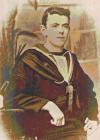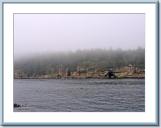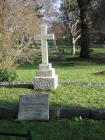1
John Montgomery, Quartermaster:A Victim of the Valencia Disaster
As told by Chris Hay, Great nephew of John Montgomery
John Montgomery was born June 27th, 1879 in Peebles, Scotland. He was the eldest son of John Montgomery, senior, and Barbara Allen Campbell. His father owned a butcher business in Peebles and being successful, he became a councilor and "Dean of Guild" for the town. John Montgomery Jr. eventually apprenticed as a butcher with his father. However, seeking a more adventurous life, he decided at age 16 to join the British Royal Navy with his first posting on the HMS Caledonia. He saw active service for 7 years on 7 ships. Then, on January 14, 1902, he was posted to HMS Grafton.
The HMS Grafton had first seen duty with the China Fleet where she served until 1900. In 1902, after a refit, she joined the Pacific Station in Esquimalt, BC, serving there as flagship for three years. John Montgomery served as Petty Officer 2nd Class on the Grafton then on October 18, 1902 left the navy to seek other work on the pacific coast.
It is believed that by 1906 Montgomery had been hired as quartermaster on the SS City of Puebla. Owned by the Pacific Coast Steamship Company, its regular run was San Francisco to Seattle. In January 1906 the City of Puebla was laid up for repairs in San Francisco, and the steam ship Valencia took over its regular run. The SS Valencia had been purchased in 1902 to cover the California to Alaska run. The captain and chief officer of the Valencia joined many of the crew from the City of Puebla, including John Montgomery.
3
On Saturday, January 20th, 1906, the Valencia left San Francisco bound for Victoria, B.C. and Seattle, Washington. The Final Report of Commission on the Valencia Disaster [April 14,1906] shows that she carried 108 passengers, 9 officers and 65 crew. On Monday, January 22nd, the Valencia unknowingly missed the entrance to the Straight of Juan de Fuca due to inclement weather. At approximately 11:50 pm the ship, facing strong winds and rain, struck the southwest coast of Vancouver Island in the vicinity of Shelter Bight.
The disabled ship was less than 100 yards from shore but the surrounding sheer rock
cliff made any escape by that means almost impossible. For over two days the passengers and crew were held prisoner by the sea while most of those who tried to leave the ship soon drowned or died of exposure. Other ships came to attempt a rescue but felt unable to get close enough. During the morning of Tuesday, January 23rd, the Valencia started to break apart. At 8:00 am Captain Johnson called for a volunteer crew to launch the last lifeboat #5. Manned by Boatswain Timothy J. McCarthy it was lowered down the side by ropes called falls. John Montgomery also to have gone in this boat had remained on deck to help in its dangerous lowering. As the lifeboat descended rapidly and its launch appeared hopeful John quickly attempted to join the others by sliding down the fall. Tragically, he was not quick enough and due to the cold and wet conditions likely lost his grip, fell into the water and was swept to his death. Ironically, this was the only
lifeboat that made it to safety eventually landing about 12:30 pm 8 miles northwest of the wreck.
5
On Wednesday January 24th, a rescue party from the Carmanah Light Station arrived at about 11:30 am at the site of the Valencia wreck just in time to observe a huge breaker causing the final destruction of the ship with the remaining victims on board. With the recovery of bodies came many enquiries regarding individuals who had been on board the Valencia. M.C. Griffith of Vancouver enquired as to his brother-in-law, John Montgomery. Mr. Griffith described himas 5 feet 10 inches in height and 175 lbs. in weight, smooth-shaven, with heavy shoulders, and having tattooed arms and scars on his chest and temple.Victoria's Daily Colonist for February 6, 1906, reported that the tug Lorne had returned from the search the previous day with the bodies of 9 men and 3 women. Four bodies had been definitely identified and two tentatively. One of the latter was likely that of quartermaster John Montgomery. The description was similar to that given by Mr. Griffith: "Male - 5 feet 8 inches, long hair, features unrecognizable: no clothing. On left arm a British and Danish shield tattooed in blue and red, also a star with blue border tattooed on same arm. On right arm, three cross fishes tattooed in blue." Montgomery's naval record showed his actual height to be 5 feet 7 inches which is very close to the description of the recovered body. The most distinguishing feature, however, is that of the tattoo showing three crossed fish. This unusual feature is actually the coat of arms for the Town of Peebles, Scotland where John was born and raised. This evidence strongly implies that the body was indeed that of John Montgomery.
6
The site of the wreck of the Valencia2005
West Coast of Vancouver Island, British Columbia, Canada
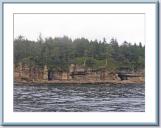
7
This body along with many others, mostly unidentified, was interned at Ross Bay Cemetery in Victoria. Although never positively identified, it appears that Montgomery was buried in the grave marked "Number 11, Unknown". Based on a review of many of the original records of this disaster, this grave can be safely said to be his final resting place.John Montgomery's is only one of the many life stories that ended on that fateful day. The total number of lives lost on the Valencia was 136 including 7 officers, 33 crew and 96 passengers. All of the women and children aboard had perished. The 37 survivors included 2 officers, 23 crewman and 12 passengers. Although not responsible for the largest loss of life, the Valencia is regarded as one of the most horrific and tragic to have ever occurred on the Pacific Coast.
The loss of John Montgomery's life on the 'Valencia' was to soon have an important influence in early Vancouver history. In 1908 his father, John Senior, immigrated to Vancouver with his wife and two younger daughters. Enamoured with the beauty of Stanley Park, he was soon hired as a park gardener where his gardening expertise led to his creation of the Stanley Park Rock Garden in 1911. Lasting for over 50 years this major park attraction became an early Vancouver landmark.
10
Memorial stone for George Henry Jesse in the Ross Bay Cemetery, Victoria, BCVictim and hero in the Valencia disaster.
Information pertaining to George Henry Jesse kindly supplied by his great niece, Susan crow (daughter of Claudia Robbins, nee Jesse) of Victoria BC
From the Seattle "P I" dated January 30, 1906
"Survivors tell of the heroism of G.H. Jesse who is a prominent British Columbia oarsman, in refusing to take a place on the raft on which Connors and Long escaped, that he might remain to assist Miss Laura Van Wyck, a San Francisco society girl. Connors said:"I saw Jesse and know him, as he was a little further on the mast than I when the top-mast broke. I was carried down, and he had a hard time to keep in the rigging, holding Miss Van Wyck. "I called to him to come down and take a chance on the life raft, but he replied; "No, I have some one here to look after, and will stay and take my chances."
And from the Spokesman Review....
Victoria, B.C. Jan. 29 - Frank Connors and George Long, two survivors of the Valencia, who are in the marine hospital here, said this afternoon that G.H. Jesse, a Victoria passenger, was in the rigging above them before the mast broke and Connors and Long went on the raft which drifted into Barclay Sound. Jesse was holding Miss Laura Van wyck of San Francisco in the rigging above where Long was Clinging. When the mast broke above them Long said to Jesse:
"Come on and take a chance on the raft."
Jesse replied:
"I can't; I've got someone to look after here."
Both say that Jesse was one of the gamest of those in the rigging. He was continually encouraging those clinging there. He was an athlete, noted throughout the northwest, and was a member of the championship four of the northwest for several seasons.
11
Memorial stone for George Henry JesseDecember, 1905
Ross Bay Cemetary, Victoria, British Columbia Canada
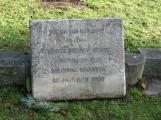
12
Memorial stone for George Henry Jesse in the Ross Bay Cemetery, Victoria, BCVictim and hero in the Valencia disaster.
Information pertaining to George Henry Jesse kindly supplied by his great niece, Susan crow (daughter of Claudia Robbins, nee Jesse) of Victoria BC
From a newspaper clipping belonging to Mrs. Crow:
Proposal to Reward Deeds of Heroism commission will be Requested to Ascertain those Particularly Courageous Among Survivors
Then Mayor Morley proposes taking steps to have officially recognized the deeds of George H. Jesse, the Victorian,
whose efforts to contribute something to the comfort of the women and children as they watched the stranded vessel break slowly to pieces and death draw nearer, which have been recounted by many of the survivors. The Mayor intends outlining to those controlling the funds in question the peculiarly sad circumstances of his loss, and is confident that something will be done in order that the bereaved relatives may have some tangible evidence of the
universal appreciation of the marked bravery Mr. Jesse displayed.
and from a february 13, 1906 clipping:
PAID TRIBUTE TO GEORGE H. JESSE FIREMAN'S TESTIMONY AT VALENCIA INQUIRY
To Mr. Lawson, witness said that women could not have stood the exposure to which he was subjected while upon the raft. Asked regarding the passengers, witness paid a tribute to the courage of George H. Jesse. He said he Took a Prominent Part in all that was done aboard. Always active in handling linesm and making things as orderly and comfortable as possible, he particularly attracted his attention. Mr. Jesse, witness said, made no effort to get aboard the raft.
